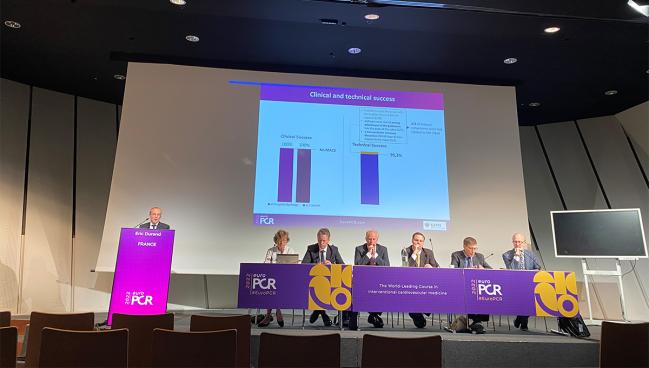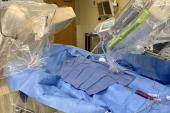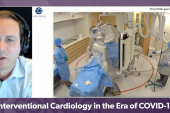Robotic PCI Safe, Feasible in Noncomplex Cases: R-Evolution
Using the R-One device shaves procedural time and reduces operator radiation exposure, especially with experience.

PARIS, France—Robotic PCI is safe and feasible for patients and improves safety and ergonomics for the operator, according to the R-Evolution study.
A clinician using the R-One system (Robocath; Rouen, France), which received CE Mark approval in 2019, uses joysticks in the control station to remotely operate catheters, guidewires, balloons, and stents, theoretically without being exposed to harmful radiation. At this time, Eric Durand, MD, PhD (Normandie University, Rouen, France), explained to TCTMD, the system can only manipulate one wire at a time, with the potential to put a second on standby.
“It's very easy to use,” he said, presenting the data today during EuroPCR 2022. “There are single-use cassettes that we have to change for each patient like the other system, [but it’s a] very easy platform. . . . I think we are at the beginning of the story.”
The data are not the first to explore the potential of robots in the cath lab, with prior studies of various systems showing technical success and improved operator wellness and even the ability to protect staff against COVID-19.
Pieter Smits MD, PhD (Maasstad Hospital, Rotterdam, the Netherlands), who was a co-investigator on the R-Evolution study and served as a co-moderator during the session, told TCTMD that he is “always the person who's running into walls” when playing video games, but with this particular system, he has proved more adroit. “This joystick manipulation was really easy to learn actually.”
And as someone with a history of orthopedic injuries, Smits added that not having to wear heavy lead for the procedures was a welcome experience, as was the knowledge that he was exposed to less radiation. However, he admitted that robotic PCI “takes away a little bit [of] the fun.”
Panelist Chaim Lotan, MD (Hadassah-Hebrew University, Jerusalem, Israel), said he worries about not being able to rely on tactile feedback that interventionalists spend years honing. “Can we train the robot to feel the touch?” he asked, following the study presentation.
Pedro Lemos, MD, PhD (Hospital Israelita Albert Einstein, São Paulo, Brazil), who has used the Corindus CorPath system for 2 years and was also part of today’s panel discussion, said he’s been pleasantly surprised by the experience. “When we started doing the robotic PCI, we thought that we would lack or miss this type of feeling,” he said. “It’s totally untrue.”
Durand also pointed out that in some ways, using the system is like teaching fellows. “I have no hand feeling, only eye feeling. So, we are comfortable with that. It is not a problem for me.”
High Clinical, Technical Success
For the study, Durand and colleagues included 62 patients with 64 lesions (mean age 65.4 years; 80.6% male) treated across six European centers between 2019 and 2021. Patients were excluded if they had lesions longer than 38 mm or wider than 4 mm or if they had severe calcification and tortuosity, bifurcations, ostial lesions, restenosis, left main lesions, or saphenous vein grafts. Radial access was used primarily (96.8%), and postdilatation was mandatory in about one-third of cases.
Clinical success was 100%, with no MACE through 1 month, and technical success was 95.2%. There were three conversions to manual PCI, two of which were not related to the robot. Median procedure duration was 20 minutes shorter for fully robotic procedures compared with those that were not (17.5 vs 37.5 minutes). Additionally, median contrast volume was lower (84.5 vs 110 mL). Lastly, radiation exposure as measured under and on top of the lead apron was 84.5% and 77.1%, respectively, lower for an operator who remained in the robotic control station compared to someone right next to the patient.
Lastly, the operators observed improved results with increased experience, with less manual conversion (0 vs 10.7%; P = 0.09), lower total procedure duration (35.5 vs 45.2 minutes; P = 0.008), and shorter robotic procedure duration (17.5 vs 22.2 minutes; P = 0.07), thus indicating a learning curve.
Future Potential
Durand explained that, in reality, the radiation exposure to the operator would depend on who else might be working alongside them. “If you work alone, you have to move [near] patients to advance the guidewire, the stent, or balloon in the robot and you have to go back to your chair in your radioprotected station,” he said. “But if you're working with a fellow or with a nurse who will introduce the wire, the balloon . . . you can stay [in] your chair and you can work very comfortably with very good ergonomic position to treat the patients.”
Lemos explained that robotic PCI has “changed the environment” of his cath lab, mostly for the better. However, he said, “if you think about the training of the new fellows, it's challenging because . . . how [can they] learn how to do the manual things? We'll see how it goes.”
For now, Durand recommended training new interventionalists in both manual and robotic PCI, if only because operators will need to be able to convert on a dime to manual PCI if using the robot.
Smits added that while the tactile feedback is gone with robotic PCI, “you have a device that will offer you very precise positioning. So, you miss something, and you add something.”
Durand said the biggest hurdles going forward are expense, especially since a new cassette has to be used with each new patient, as well as the effort needed to convince operators to get on board and gain experience. Next, he’d like to see “more registries showing that it is feasible in more-complex lesions,” Durand said, adding that while he’d want a randomized study comparing manual and robotic PCI, deciding what to show with a trial like that would be difficult given that lower radiation exposure has already been proven. “Noninferiority as compared to manual PCI?” he wondered. “Probably. It's the only thing we need to convince everyone.”
With robotic systems like R-One, said panelist David Moliterno, MD (University of Kentucky, Lexington), there is the potential to perform remote interventions in the future. “I think it's taking interventions to a broader arena,” he said. “Say, neurointerventions, right? There are plenty of interventional cardiologists, but very few interventional neurologists to do acute stroke thrombectomy. I could see if you were at home and your fellow could at least get access, you could easily do a stentriever and pull out the thrombus and really expand care to acute stroke patients.”
Yael L. Maxwell is Senior Medical Journalist for TCTMD and Section Editor of TCTMD's Fellows Forum. She served as the inaugural…
Read Full BioSources
Durand E. Safety and efficacy of robotic-assisted PCI using R-One system: a European prospective multicentric single-arm study. Presented at: EuroPCR 2022. May 18, 2022. Paris, France.
Disclosures
- Durand reports receiving honoraria or consulting fees from Edwards Lifesciences and Robocath.
- Moliterno reports receiving honoraria or consulting fees from Janssen.
- Lotan and Smits report no relevant conflicts of interest.





Comments